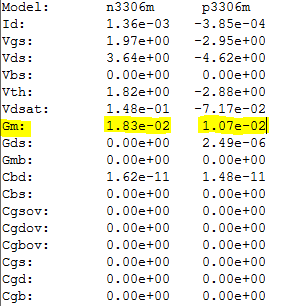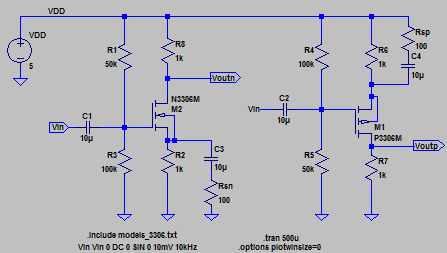 These are the simulation results of the amplifier |  |
 | |
Experiment 1: The common-drain amplifier

These are the simulation results of the amplifier

The common-drain amplifier is also
known as the source follower amplifier. It is called common-drain because
both the input and the output have the drain in common. It is called a source follower because the output of the
amplifier is located at the source and follows the signal at the input.
This amplifier configuration has a voltage gain close 1 which is
calculated further below.
| Amplifier circuits | NMOS circuit | PMOS circuit |
| Scope reading of the gain | ||
| Scope reading of the Input Resistance Test | ||
| Scope reading of the Output Resistance Test |
| In order to test the input and output resistance of the circuit, we connect a resistor in series that is the size of our caculated resistance and apply a test voltage. If our calculated resistance is correct, the resistor we place in series will have a voltage drop of half of our test voltage. If not, the equation on right helps us calculate the measured Resistance. |
Below are the calculations for INput Resistance, OUTput Resistance and gain of the amplifier. We will use 18mV for the gm of the NMOS and 11mV for the gm of the PMOS. These are the values which also obtained in the .op simulation of our circuit. Although they are not exact due to the changing of gm. They will help us stay consistent with our calculations throughout our experiments.
| Common-Drain amplifier Table | Calculated Gain | Measured Gain | Calculated input Resistance | Measured Input Resistance | Calculated Output Resistance | Measured Output Resistance |
| NMOS amplifier | 0.947 | 1.2 | 33.33k ohm | 26.4k ohms | 52.63 ohms | 58.5 ohms |
| PMOS amplifier | 0.947 | 1.2 | 33.33k ohm | 34.7k ohms | 83.3 ohms | 192 ohms |
 To the left is our simulation schematic and below are out simulation results To the left is our simulation schematic and below are out simulation results | |
 | |
The common-source amplifier is called common-source because both the input and the output have the source in common. R1 and R3 create a voltage divider to bias the gate voltage on the NMOS. This is also accomplished by R4 and R5 in the PMOS circuit. The input is capacitively coupled on both circuits to maintain the biasing.
| Amplifier circuits | NMOS circuit | PMOS circuit |
| Scope reading of the gain | ||
| Scope reading of the Input Resistance Test | ||
| Scope reading of the Output Resistance Test |
Below are the calculations for INput Resistance, OUTput Resistance and gain of the amplifier. We will use 18mV for the gm of the NMOS and 11mV for the gm of the PMOS. We notice that increasing the Rsn or Rsp, decreases our gain.
| Common-source amplifier Table | Calculated Gain | Measured Gain | Calculated input Resistance | Measured Input Resistance | Calculated Output Resistance | Measured Output Resistance |
| NMOS amplifier | -6.83 | -5.2 | 33.33k ohm | 26.4k ohm | 1k ohm | 724 ohm |
| PMOS amplifier | -5.4 | -2.96 | 33.33k ohm | 34.7k ohm | 1k ohm | 960 ohm |
| Amplifier circuits | NMOS circuit | PMOS circuit | |
| Scope reading of the gain | |||
| |||
| Scope reading of the Output Resistance Test |
Below are the calculations for INput Resistance, OUTput Resistance and gain of the amplifier. We will use 18mV for the gm of the NMOS and 11mV for the gm of the PMOS. We notice that increasing the Rsn or Rsp, decreases our gain.
| Common-gate amplifier Table | Calculated Gain | Measured Gain | Calculated input Resistance | Measured Input Resistance | Calculated Output Resistance | Measured Output Resistance |
| NMOS amplifier | 6.55 | 5.28 | 152.6 ohm | 418 ohm | 1k ohm | 980 ohm |
| PMOS amplifier | 5.4 | 2.83 | 183.3 ohm | 335 ohm | 1k ohm | 1.8k ohm |
| Hand Calculations | id = vsg1 * (gm1) id = vgs2 * (gm2) because vsg = vgs = vin Vout/Vin = (R1)*(gm1 +gm2) Vout/Vin = 100k * (.011 + .018) Vout/Vin = 2900 |
| Using a 100kohm Resistor | Using a 510kohm Resistor |